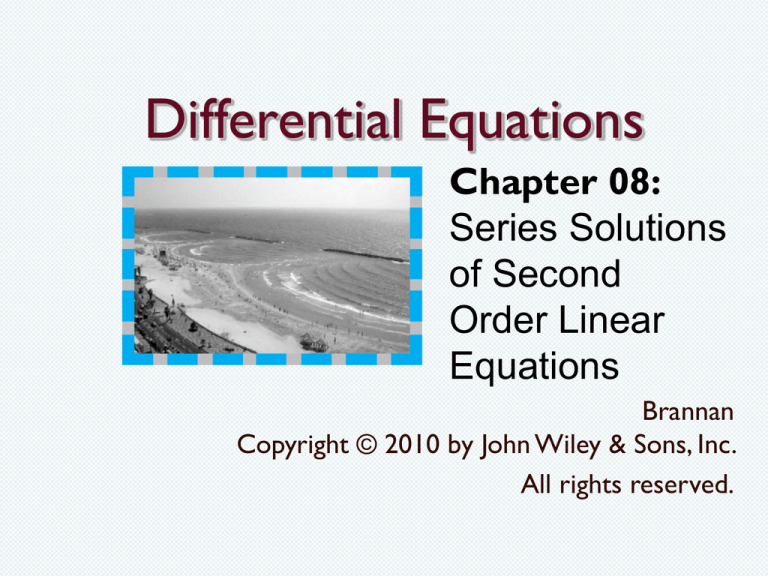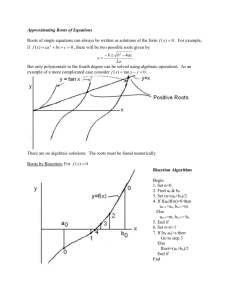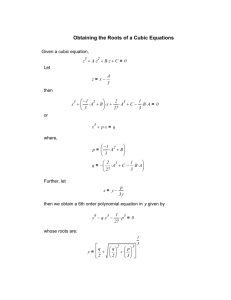
Differential Equations
Chapter 08:
Series Solutions
of Second
Order Linear
Equations
Brannan
Copyright © 2010 by John Wiley & Sons, Inc.
All rights reserved.
Chapter 8 Series Solutions of
Second Order Linear Equations
The general solution of a linear second order
equation P(x)y'' + Q(x)y' + R(x)y = 0 is y = c1y1(x)
+ c2y2(x), where y1 and y2 are a fundamental set of
solutions of the differential equation.
To deal with equations that have general
nonconstant coefficients, we need alternative
solution techniques. For some applications we
may find that approximations using an initial value
problem solver are satisfactory for our needs.
However there are some variable coefficient
equations that frequently recur in applications
where infinite series representation of solutions
useful.
Chapter 8 - Series Solutions of
Second Order Linear Equations
8.1 Review of Power Series
8.2 Series Solutions Near an Ordinary Point,
Part I
8.3 Series Solutions Near an Ordinary Point,
Part II
8.4 Regular Singular Points
8.5 Series Solutions Near a Regular Singular
Point, Part I
8.6 Series Solutions Near a Regular Singular
Point, Part II
8.7 Bessel’s Equation
8.1 Review of Power Series
DEFINITION 8.1.1 - A power series is an
infinite series of the form
The constants a0, a1, a2, . . . are called the
coefficients of the series, the constant x0 is
called the center of the series, and x is a
variable. Setting x0 = 0 in Eq. (1) gives us a
power series centered at x0 = 0:
Convergence Concepts
DEFINITION 8.1.2 A power series
is said to converge at a point x if the sequence of
partial sums
converges as m →∞. The sum of the series at the
point x is defined to be the limit of the sequence of
partial sums, and we write
If the limit of the sequence of partial sums does not
exist, then the series is said to diverge at x.
Example
DEFINITION 8.1.3
Theorems
THEOREM 8.1.4 (absolute convergence
implies convergence)
THEOREM 8.1.5 (The Ratio Test)
Radius of Convergence.
If
is a power series, then either
1. The series converges absolutely for all x, or
2. The series converges only for x = x0, or
3. There exists a number ρ > 0 such that
converges absolutely for | x − x0 | < ρ and diverges for
| x − x0 | > ρ.
The number ρ in Case 3 is called the radius of
convergence and the interval | x − x0 | < ρ is called the
interval of convergence. This case is illustrated by the
shaded region in Figure 8.1.1. We write ρ =∞ in Case 1 and
ρ = 0 in Case 2. Using these conventions, we can state that
each power series has a radius of convergence ρ, where 0
≤ ρ ≤∞. If 0 < ρ < ∞, the series may either converge or
diverge when |x− x0| = ρ.
FIGURE 8.1.1
The interval of convergence of a power
series if 0 < ρ < ∞.
Example
Question
Answer
The given power series converges for −3 ≤
x < 1 and diverges otherwise. It converges
absolutely for −3 < x < 1 and has a radius of
convergence 2.
Algebraic Operations on Power
Series
THEOREM 8.1.6
Taylor Series and Analytic
Functions
DEFINITION 8.1.7 Let f be a function with
derivatives of all orders throughout the
interval |x − x0| < ρ, where ρ > 0. Then the
Taylor series of f at x0 is the power series
DEFINITION 8.1.8 A function f that has a
power series expansion of the form
with a radius of convergence ρ > 0 is said to
be analytic at x0.
Shift of Index of Summation
Shifting the index of summation in a power
series is analogous to changing the variable
of integration in an integral. This operation, in
conjunction with Theorem 8.1.6, is a useful
tool for computing power series solutions of
differential equations.
EXAMPLE
8.2 Series Solutions Near an
Ordinary Point, Part I
It is sufficient to consider the homogeneous
equation
(1)
Examples
Ordinary and Singular Points
DEFINITION 8.2.1 A point x0 is said to be
an ordinary point of Eq. (1) if the
coefficients P, Q, and R are analytic at x0,
and P(x0) = 0. If x0 is not an ordinary point,
it is called a singular point of the
equation.
If x0 is an ordinary point, then we can
divide Eq. (1) by P(x) to obtain
where p(x) = Q(x)/P(x) and q(x) = R(x)/P(x)
are analytic at x0, and therefore continuous
in an interval around x0.
Examples
We now take up the problem of solving Eq. (1)
in the neighborhood of an ordinary point x0.
We look for solutions of the form
Example 1.
Answer
y=
Example - Airy Equation.
The general solution of Airy’s equation is
The Airy Functions Ai(x) and Bi(x)
Since Airy’s equation is linear, we can form
other fundamental sets of solutions by taking
pairs of linear combinations of y1 and y2 in
above eq., provided that the resultant pairs
of functions are linearly independent. Using
the gamma function, denoted by Γ(p) and
defined by the integral
The Airy Functions Ai(x) and Bi(x)
Asymptotic analysis yields the following
approximations to Ai(x) and Bi(x) for large
values of |x|:
(a) The graphs of Ai(x) and the asymptotic approximations
for values of |x| ≥ 0.2. (b) The graphs of Bi(x) and the
asymptotic approximations for values of |x| ≥ 0.2.
8.3 Series Solutions Near an
Ordinary Point, Part II
In the preceding section, we considered the problem
of finding solutions of (1)
where P, Q, and R are polynomials, in the
neighborhood of an ordinary point x0. Assuming that
Eq. (1) does have a solution y = φ(x) and that φ has a
Taylor series (2)
which converges for |x − x0| < ρ, where ρ > 0, we found
that the an can be determined by directly substituting
the series (2) for y in Eq. (1).
Let us now consider how we might justify the
statement that if x0 is an ordinary point of Eq. (1),
then there exist solutions of the form (2). We also
consider the question of the radius of convergence of
such a series.
General Solutions in
Neighborhoods of Ordinary Points
THEOREM 8.3.1
Examples
1. What is the radius of convergence of the
Taylor series for (1 + x2)−1 about x = 0?
2. Determine a lower bound for the radius of
convergence of series solutions of the
differential equation
(1 + x2)y'' + 2xy' + 4x2 y = 0
about the point x = 0 and about the point x =
−1/2.
8.4 Regular Singular Points
We consider the nonconstant coefficient
equation
P(x)y'' + Q(x)y' + R(x)y = 0, (1)
where x0 is a singular point. This means that
P(x0) = 0 and at least one of Q and R is not
zero at x0.
Power series method to solve in the
neighborhood of a singular point x0, fails.
We need to use a more general type of
series expansion to solve.
Cauchy–Euler Equations
A relatively simple differential equation that has a
singular point is the Cauchy–Euler equation,
L[y] = x2 y'' + αxy' + βy = 0, (2)
where α and β are real constants.
If we assume that Eq. (2) has a solution of the form
y = xr , (3)
then we obtain
L[xr] = x2(xr) + αx(xr) + β xr = xr [r (r − 1) + αr + β]. (4)
If r is a root of the quadratic equation
F(r ) = r (r − 1) + αr + β = 0, (5)
then L[xr] is zero, and y = xr is a solution of Eq. (2).
The roots of Eq. (5)
The roots of Eq. (5) are
and F(r) = (r − r1)(r − r2).
Three possible cases:
1. Real, Distinct Roots.
2. Equal Roots.
3. Complex Roots.
1. Real, Distinct Roots.
If F(r) = 0 has real roots r1 and r2, with r1 ≠ r2,
then y1(x) = xr1 and y2(x) = xr2 are solutions of
Eq. (2).
Since W(xr1 , xr2 ) = (r2 − r1)xr1+r2−1 is
nonvanishing for r1 ≠ r2 and x > 0, it follows
that the general solution of Eq. (2) is
y = c1xr1 + c2xr2 , x > 0.
(7)
Note that if r is not a rational number, then xr
is defined by xr = er ln x.
Example: Solve
2. Equal Roots.
If the roots r1 and r2 are equal, then we
obtain one solution as y1(x) = xr1.
A second solution of Eq. (2) is
y2(x) = xr1 ln x, x > 0
By evaluating the Wronskian, we find that
W(xr1 , xr1 ln x) = x2r1−1.
Hence xr1 and xr1 ln x are a fundamental set
of solutions for x > 0, and the general
solution of Eq. (2) is
y = (c1 + c2 ln x)xr1 , x > 0.
Example: Solve
3. Complex Roots.
Finally, suppose that the roots r1 and r2
of Eq. (5) are complex conjugates, say,
r1 = μ + iν and r2 = μ − iν, with ν = 0.
The general solution of Eq. (2) in this
case is
y = c1xμ cos (ν ln x) + c2xμ sin (ν ln x),
x > 0.
Example: Solve
Solutions of Euler Equation – Real
Roots
Solutions of an Euler equation;
complex roots with a negative real
part.
Solutions of an Euler equation;
complex roots with a positive real
part.
Solutions of an Euler equation;
repeated roots.
Table 8.4.1
DEFINITION 8.4.1- Regular and
Irregular Singular Points
EXAMPLE







